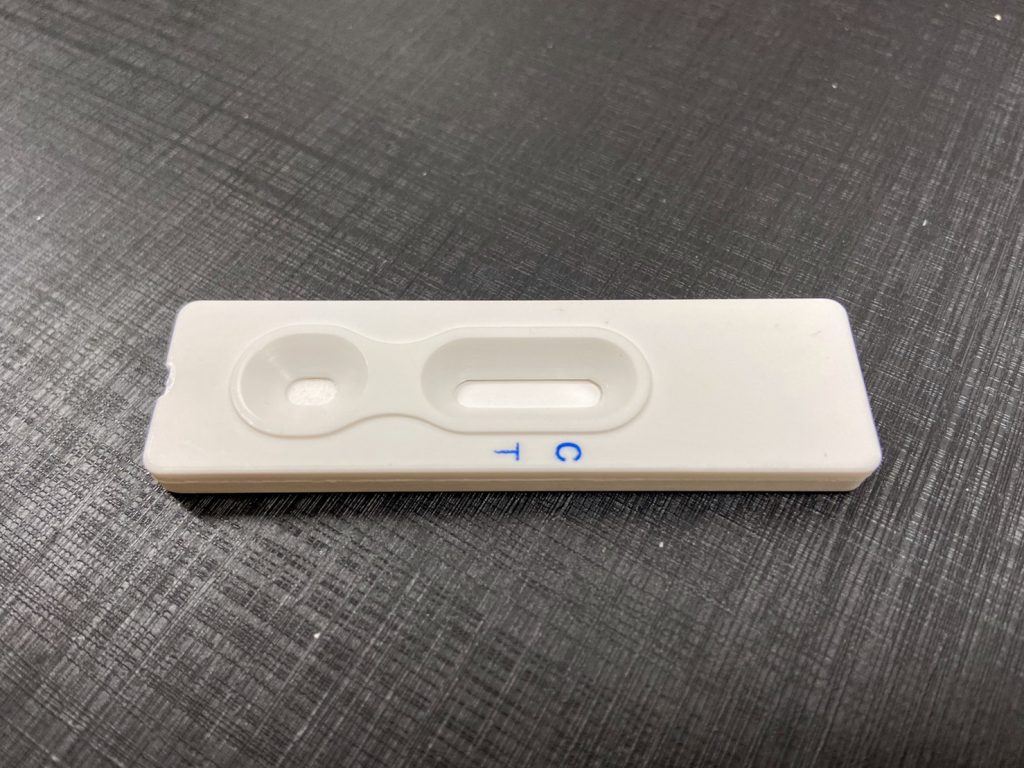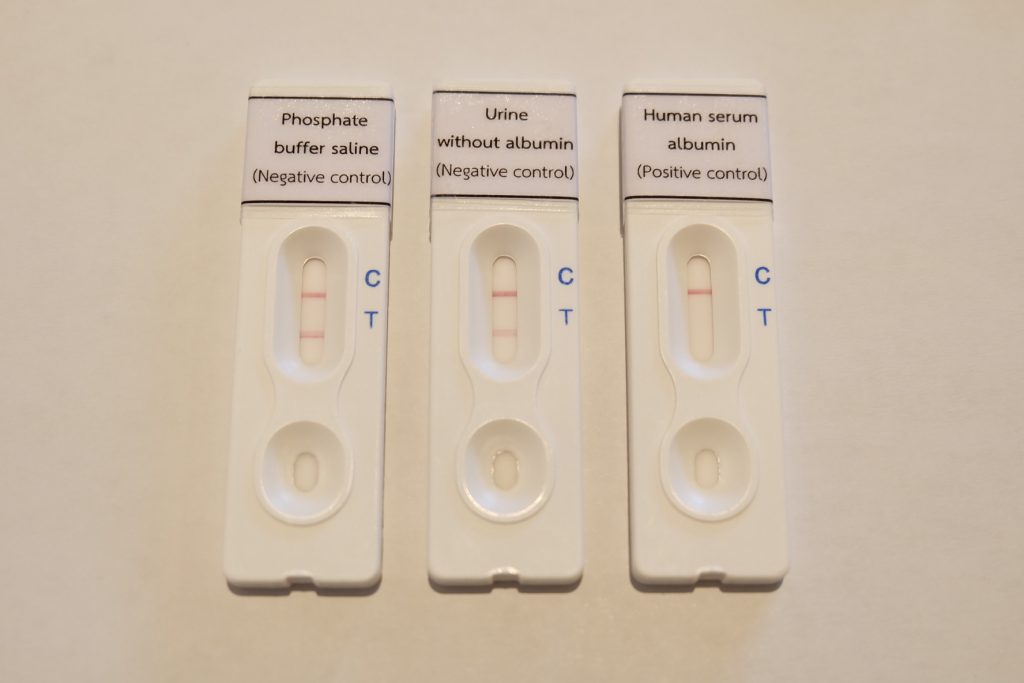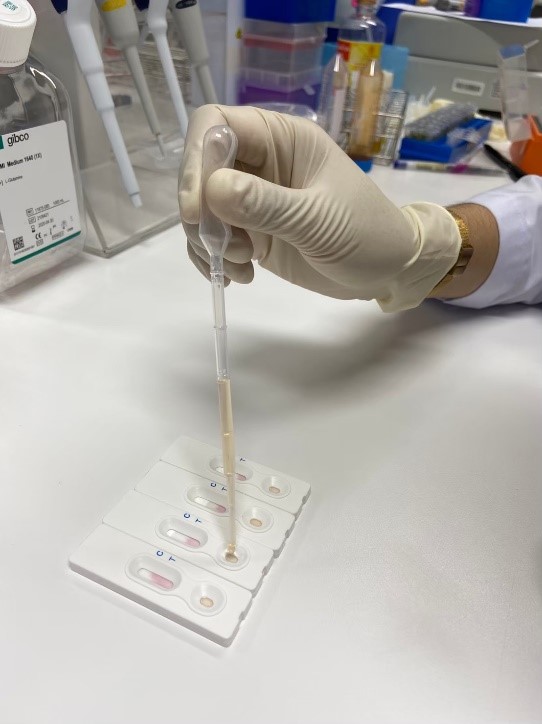Chulalongkorn University

A Chula research team has developed a screening strip kit to detect the early stage of chronic kidney disease (CKD) that’s easy to use, yields quick results, increasing the chance of being cured for patients, and helping to cut over 10 billion baht of the ever-increasing annual healthcare costs for CKD patients. The CKD screening strip kits are expected to be released early next year.
CKD poses as a silent threat that chips away at the patients’ quality of life. Each year, 17 percent of the Thai population, or eight million people are diagnosed with kidney disease, most of whom are asymptomatic. So, they do not seek medical attention and carry on with their damaging behavior to worsen the kidneys’ poor condition.
“By the time the body shows the typical symptoms of CKD, like fatigue, lack of energy, and swelling, the patient would have already entered the acute stage, in which only 30 percent of the kidneys are functioning. Therefore, the disease must be detected at the early stage to slow down the degeneration of the kidneys, and to give the patient a better chance to be cured,” Assoc. Prof. Dr. Nattachai Srisawat, Department of Internal Medicine, Faculty of Medicine, Chulalongkorn University, explained the possibility of reducing the number of CKD patients in Thailand.
According to Assoc. Prof. Dr. Nattachai, at present, the National Health Security Office (NHSO) has spent around 10 billion baht to enable patients to undergo both hemodialysis and peritoneal dialysis. This budget is expected to increase by 500 million baht annually because of the steady increase in the number of kidney disease patients. (Each person has an average cost of 200,000 baht/year). If no measures are taken to stop this upward trend of CKD, there will be shortages of the budget and medical treatment.
With research funding from the Health Systems Research Institute (HSRI), Assoc. Prof. Dr. Nattachai, in collaboration with Assoc. Prof. Dr. Kittinan Komolpis, the Institute of Biotechnology and Genetic Engineering, Chulalongkorn University, developed an “innovative self-screening strip kit for an early stage of CKD,” so patients can perform the test by themselves.
“If there is a test kit that is easily accessible, it will raise patients’ awareness about kidney disease, so that they can receive treatment early on without having to wait until they get to the acute stage that requires dialysis. If the test kit is adopted by the government, they will be able to reduce the budget used to aid dialysis patients.”
CKD screening strips – user-friendly with quick results
Generally, there are two methods of CKD screening: blood tests that take a long time and require the patients to travel to the hospital and a urine test for protein, and not the urine microalbumin test, which is more specific to CKD. Though the hospitals do perform urine microalbumin tests, lab results can only be read by medical personnel.

“The innovative screening strips for early-stage CKD screens for microalbuminuria, the clearest indicator of CKD.”
“Patients can perform the screening tests and read the results themselves at home. The painless screening from urine is as simple as a pregnancy test that’s available in the market. The urine can be collected in the morning after one wakes up or before breakfast. Only three drops of urine are needed on the test strip. Wait 15 minutes. If one bar shows, the microalbumin is abnormal, and two bars mean the microalbumin value is within the normal range,” Assoc. Prof. Dr. Nattachai explained.

Based on the trials with CKD patients and people without CKD, the strips had a sensitivity of 86 percent, specificity of 94 percent, and an accuracy of 87 percent. The research findings have been published in a medical journal, and the screening strips will soon be tested in the community with approximately 2,500 patients.
Who are the CKD screening strips for?
Though CKD remains latent in its initial stage, the groups of people who should take screening tests are those suffering from diseases or physical conditions that may affect kidney function, such as diabetes, high blood pressure, and the elderly over 60.
“These groups of people should be tested at least once a year to keep informed of the kidney function and find a way to deal with it promptly,” Assoc. Prof. Dr. Nattachai suggested.
Apart from the above high-risk groups, teenagers and working-age people can’t be careless, especially if they are not mindful eaters.
“Some people may have hidden conditions of CKD. So, they should also get tested given a chance. Normally, as people get older, their kidney function also declines.”

Behavior modification – the key to kidneys care
Assoc. Prof. Dr. Nattachai suggests that when diagnosed with CKD, the first thing people should do is to undergo more tests to check the stage of their kidney function with a thorough blood test and urine test. More importantly, patients have to modify their behavior.
“Major behavioral modification is dietary adjustments. Avoid sugary, salty foods, and red meat. If you want to eat protein, opt for protein from egg whites or fish instead. Exercise along with diet control is also necessary,” Assoc. Prof. Dr. Nattachai suggested.
“If you don’t have kidney disease, the best prevention is to adjust your eating habits as well. Avoid salty foods, because your kidneys have to work harder to flush out the sodium. If the kidneys are unable to excrete salt, it can lead to swelling, and high blood pressure which results in the deterioration of the kidneys.”
Assoc. Prof. Dr. Nattachai also added that “healthy people who want to consume fish sauce should not take more than three teaspoons or one tablespoon per day. The fish sauce that is advertised as having low sodium is not recommended for CKD patients, because low-sodium fish sauce is often high in potassium which is not good for kidney function either. You should also check to see if the brand of low-sodium fish sauce is also low in potassium.
“People who might wish to take whey protein have to be selective as well. Even for healthy people, consuming a lot of whey protein can cause an excess that makes the kidneys work harder as well.”
Currently, the CKD screening strip kit is in the process of being registered with the Food and Drug Administration (FDA), and if approved by the end of this year, it can be released early next year. The price of the strips will be comparable to the products available in the market. In the future, the research team will look for ways to increase the local production capacity for the test substance used to detect urine microalbumin, to reduce production costs, which will bring down the price of the strip test.
“Though the test kits are intended for home use, we hope this test will be included in the National Health Security system and made available to everybody, including people in rural and remote areas who may have CKD, but do not have any symptoms, so that they gain easier access to screening without having to travel long distances to the hospital,” Assoc. Prof. Dr. Nattachai concluded.